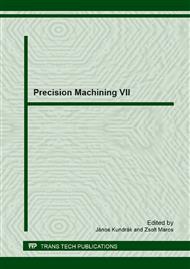p.50
p.55
p.62
p.68
p.77
p.82
p.89
p.95
p.100
Applying Projective Geometry in Design of Worm Manufacturing
Abstract:
The mathematical describing of the production process in mechanical engineer work in the euclidean space model and the base of the analytical describing of the projective space model is practically identical in the form, which makes it reasonable to discuss of the production geometry to approach of the projective geometrical negotiation in the . It is a fact that in one of the cases, using the approach of a projective geometrical connection and the mathematical-kinematical model resulted in expansion in the field of production precision, specifically considering the examination of the production of the conical worm by grinding wheel. The abstraction of the production geometry on projective space model has a few results in case of conical worms. The elliptical errors in production of the conical worm with arched or anything profile by grinding wheel can be eliminated by this method way to achieve the constant pitch, the torsion of profile and others.
Info:
Periodical:
Pages:
77-81
Citation:
Online since:
October 2013
Authors:
Keywords:
Price:
Сopyright:
© 2014 Trans Tech Publications Ltd. All Rights Reserved
Share:
Citation:


